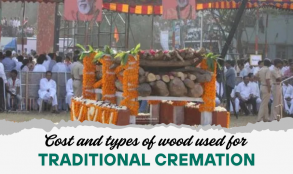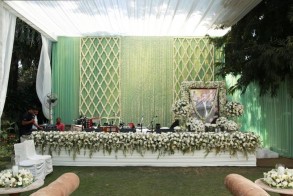Lastjourney Blog
Cost Comparison: Wood Cremation vs. Electric or Gas Cremation

 Table of Contents
Table of Contents- What is an Electric Cremation?
- What does an Electric Cremation place or an Electric Crematorium consist of?
- Functioning of the Electrical Cremation Services
- Is Electric Cremation expensive when compared with Traditional Wooden Cremation?
- Cost Breaking of Different Cremation Procedures
- Wood Cremation
- Electric Cremation
- Gas Cremation
- Government Initiatives and Future Trends
- Conclusion
After a person passes away, cremation is a common practice in Hinduism. The majority of families typically go on traditional wooden cremation as a respectable way to say goodbye to the deceased.
However, a dangerous situation is being created by the surroundings' quick increase in pollution. As a result, society is moving away from traditional hardwood cremation and toward more modern and environmentally beneficial methods.
Two very common substitutes for the conventional wooden ones are gas cremation and electronic cremation. Here is a quick rundown of how electric cremation operates, along with its benefits, drawbacks, and price.
What is an Electric Cremation?
No wood logs, cow dung cakes, or flammable materials like kerosene oil are required for electric cremation.
These are the electric crematorium's essential components.
What does an Electric Cremation place or an Electric Crematorium consist of?
An Electrical Crematorium consists of
- A Moveable Trolley
- Furnace
- Gas Cleaning System with Venture Scrubber
- Chimney approximately 100 feet
- Controls
Functioning of the Electrical Cremation Services
- The initial process of cremating a deceased body in the Electric Cremation equipment is called incineration.
- The furnace or incinerator stays at a very high temperature.
- The staff workers place the human remains or the dead body in the combustion chamber which is called retort.The crematory or retort is usually outlined with refractory bricks. These bricks help in maintaining the retort stable during the high fluctuations in temperature. In the furnace chambers there are some holes at the bottom surface.
- An Electric Crematorium is made up of double chamber cremation furnace. In the mid a strong cremation bed is available where secondary air holes are present.
- Apart from it, the electrical connections available in the Electric Crematorium, do not require any particular fittings. A simple 220 Volts electrical outlet is enough for making the furnace operational.
- The capacity of the electric furnace is usually 54 Kilo Watt. Along with it the heating coils and terminal rods will be bonded with the side walls of the furnace.
- The fitting of devices ensures the prevention of any kind of dispersion from the chamber where electric cremation takes place. It restrains the smoke and odors.
- The usual time of cremating the deceased body inside the furnace is about 60 to 90 minutes. But several other factors such as the size of the dead body and other biological reasons, may extend the cremation time.
- If any hazardous gas or other substances are produced inside the furnace during the cremation, they will be piped out from cremation chamber and cleaned by a vent scrubber with water treatment. The final hot air will be discharged with the help of 100 feet high chimney.
- Electric Crematorium system consists of necessary controls such as auto on and off, cut-off switches and other essential controls for the safety of cremation.
Also Read, 5 Myths and Facts About Electric Cremation
Is Electric Cremation expensive when compared with Traditional Wooden Cremation?
Electric Cremation has its own benefits such as reducing carbon emissions, dialing down deforestation, and keeping the environment clean, etc. But one more key benefit of choosing Electric Cremation over traditional wooden cremation is, Cost Effectiveness.
Due to the absence of any kind of large wooden logs, additional cow dung cakes, and inflammable substances, Electric Cremation is a budget-friendly option for the people. Along with it, electric cremation works on usual principle of electricity consumption. Hence, the charges are bearable for anyone.
Cost Breaking of Different Cremation Procedures
Wood Cremation
Wood cremation, also known as traditional cremation, involves burning a pyre using firewood. The costs include:
- Firewood: ₹3,000 – ₹6,000 (varies by region and availability)
- Ghee, camphor, and other offerings: ₹1,000 – ₹2,000
- Puja and priest fees: ₹2,000 – ₹5,000
- Cremation ground charges: ₹500 – ₹2,000
- Additional Expenses: Transport of the body, ceremonial items, and post-cremation rituals
- Total Estimated Cost: ₹6,500 – ₹15,000 per cremation
Advantages
- Follows traditional Hindu rituals
- Widely available across India
- Allows for complete religious ceremonies
Disadvantages
- High environmental impact due to deforestation and carbon emissions
- Rising costs of firewood
- Lengthy process (3-4 hours per cremation)
- A significant amount of ashes and residual waste
Also Read, Key Differences Between Wooden and Modern Cremation
Electric Cremation
Electric cremation uses an electric furnace to incinerate the body efficiently. The costs include:
- Cremation fee: ₹2,000 – ₹5,000 (varies by city and facility)
- Puja and priest fees (optional): ₹1,000 – ₹3,000
- Transport and miscellaneous costs: ₹500 – ₹2,000
- Total Estimated Cost: ₹3,000 – ₹8,000 per cremation
Advantages
- More affordable than wood cremation
- Faster process (60-90 minutes per cremation)
- Environmentally friendly (no deforestation, lower emissions)
- Hygienic and modern facilities
- Government-supported initiatives make it more accessible
Disadvantages
- Limited availability in rural areas
- Some families may feel it lacks traditional authenticity
- Dependency on the electricity supply, which may be unreliable in some areas
Also Read, Cost of Electric Cremation vs. Traditional Cremation: Is It Worth It?
Gas Cremation
Gas cremation uses LPG or CNG instead of firewood to cremate the body. The costs of Gas Cremation include:
- Cremation fee: ₹3,000 – ₹7,000 (varies by facility and fuel type)
- Puja and priest fees (optional): ₹1,000 – ₹3,000
- Additional Expenses: Transport, ceremonial costs, etc.
- Total Estimated Cost: ₹4,000 – ₹10,000 per cremation
Advantages
- Lower emissions compared to wood cremation
- Cost-effective alternative to traditional methods
- Faster process (90-120 minutes per cremation)
- More widely available than electric cremation
Disadvantages
- Higher initial setup costs for crematoriums
- Limited availability in smaller towns and rural areas
- Fuel availability and price fluctuations
Government Initiatives and Future Trends
- The Indian government is promoting sustainable cremation methods by:
- Subsidizing electric and gas crematoriums in metro cities
- Running awareness campaigns about eco-friendly cremation
- Encouraging families to opt for alternatives to wood cremation
- Launching modern cremation facilities with lower costs and quick service
With increasing urbanization, the future of cremation in India is likely to shift towards more sustainable options, provided they become widely accessible and culturally accepted.
Conclusion
Choosing between wood cremation, electric cremation, and gas cremation in India depends on factors like cost, availability, religious beliefs, and environmental concerns. While wood cremation is still the most common, electric and gas cremation offer more cost-effective and eco-friendly alternatives. Families should weigh these factors carefully to make an informed decision that balances tradition with sustainability.
Your email address will not be published. Required fields are marked *












